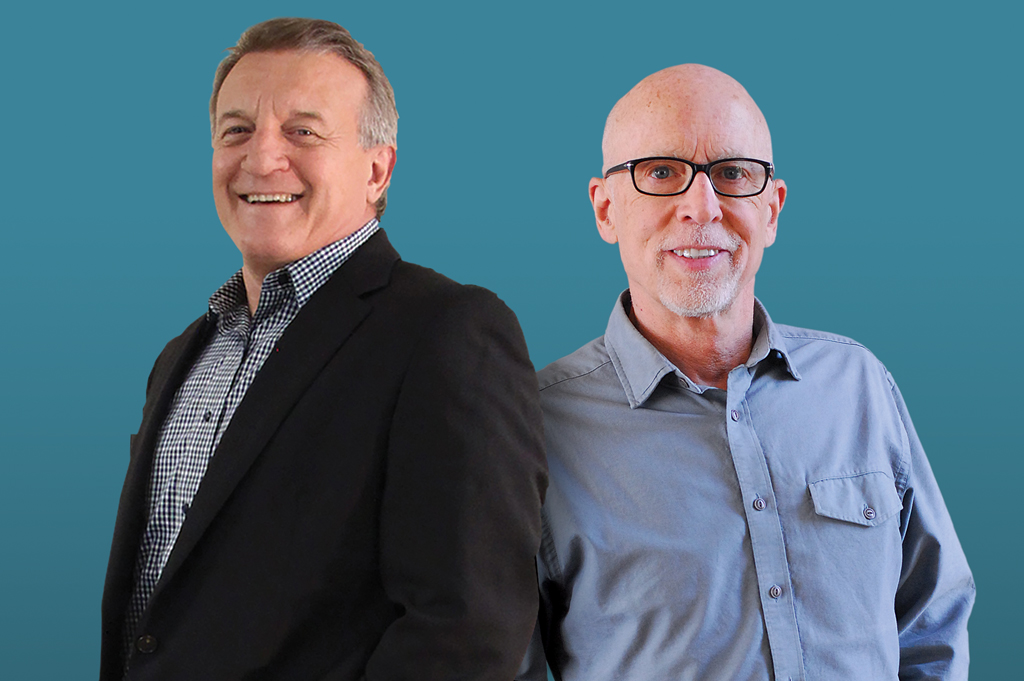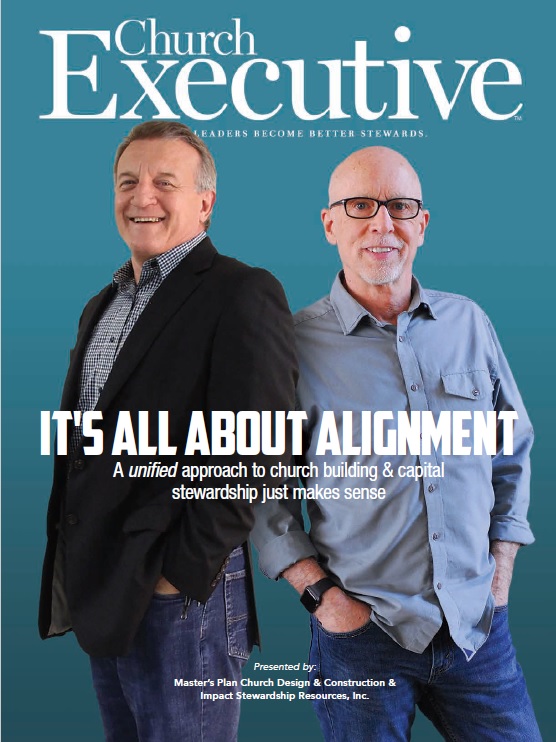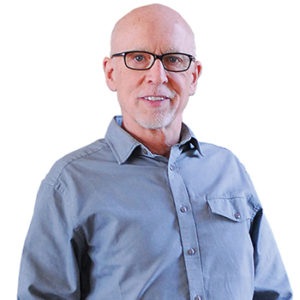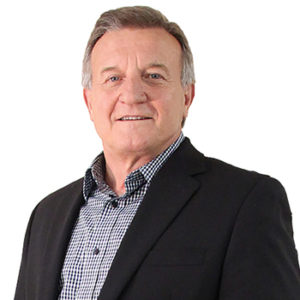
A unified approach to church building & capital stewardship just makes sense
We’ve all heard of church building projects that go like this: hire an architect and design a building. Find out the building you want is more than your church can afford. Hire a capital stewardship consultant to raise the difference. Find out the money can’t be raised.
Nobody wins.
But thinking differently — by coordinating the design and capital fundraising efforts — can pay big dividends, not just in terms of project efficiency and cost containment, but for a pastor’s peace
of mind.
“Having people with you who clearly exude a warm and infectious walk with Christ is a big deal, and [Klein] and [James] do that. The technical proficiency is there; that goes without saying. But knowing their hearts makes me feel like we’re on the same page.” — Pastor Rod MacIlvaine
Two church executives who know this firsthand are Pastor Rod MacIlvaine of Grace Community Church (GCC) in Bartlesville, Oklahoma, and Pastor Rick Lineberger of First Baptist Church in Glen Rose, Texas. For both of them, it all started when they enlisted the help of Rodney James, a former pastor who’s now president and founder of Master’s Plan Church Design & Construction in Tulsa, Oklahoma.
James was recommended to MacIlvaine by a respected non-profit stewardship consultant in the congregation. GCC’s $3.5-million building project was the third undertaking of its kind, and MacIlvaine was previously involved in two others at different churches as an elder and staff member.
For Lineberger’s part, he reached out to James after he and the long-range planning committee at his church spent a year identifying the most pressing needs: specifically, additional Sunday School and education space, as well as a ‘grand connect room’ to replace the church’s small foyer. After interviewing three different architects and a few design-build firms as well, they decided that the latter approach made the most sense for their project.
While reliable recommendations and a steep vetting process obviously factored into their selection of a building partner, both MacIlvaine and Lineberger said their ability to see a little bit of themselves in the former pastor was key.
During James’ time in church leadership, he oversaw three major building projects. This informed his design expertise, of course; it also enabled him to be uniquely transparent, open and able to share relevant, credible examples of problem-solving with potential church clients.
“I look at [James and Klein] as servant leaders. Despite their vast experience, neither came across like they knew it all and we needed to just follow; they were more than willing to customize the plan to fit our church.”
— Pastor Rick Lineberger
At one church, for instance, a full evaluation of the client’s needs (and all its current facilities) resulted in a complete change of course. The church had already engaged another builder and planned to build 50,000 square feet of additional space. Instead, James and his team came in, built 32,000 square feet of new space, renovated 50,000 square feet of existing space and saved the church $6.5 million.
“That built confidence, for me, in [James’] ability not only to understand our needs, but to understand ministry at the same time,” Lineberger said. “He talked about the present need but also helped evaluate and maximize our existing space. To me, that was really a plus.”
James acknowledges that his own “pastor side” is instrumental in helping church leaders effectively cast the project vision. “You don’t show [the congregation] pictures of something you can’t afford,” he cautioned. “I come in and say, ‘Let’s make sure that we design this facility, first and foremost, so that it facilitates your ministry. And let’s make sure you’re 99% certain you’re giving the congregation the right information when you stand in front of them.’”
We’ve got your (quarter)back

While a major building project is a blessing, it’s also a challenge. The potential for a pastor to become overwhelmed is real.
This was certainly true for Lineberger.
“Unless you’ve got an administrator who’s going to handle the project, the pastor is going to be inundated,” he said. “It’s going to take away from study time, from sermon preparation, from ministry.”
MacIlvaine, too, was wary of being swamped by his church’s building project, based on prior experience. On four separate occasions, he’d taken a more traditional, decentralized approach.
“I’ve been pastor of this church for 25 years, and one of the reasons why I resisted doing another stewardship campaign was because of the headache between the fundraising process and the design process,” he recalled.
So, the ability to have the builder act as a sort of ‘quarterback’ for the project was, understandably, very attractive for both pastors. James was able to take a 20,000-foot view of the process and how all the pieces fit together. From that, he developed and followed a game plan from beginning to end.
And what’s essential to any game plan’s success? The right partners — from subcontractors to (key and critical) capital fundraising expertise.

Minding momentum, building strategy
To this end, Chuck Klein, the president and principle owner at Impact Stewardship Resources, Inc., is a crucial link in the chain — not only for MacIlvaine and Lineberger, in this instance, but for a variety of other pastors as well.
“In terms of a sports analogy, you’re thinking about going on offense or defense — being proactive or reactive,” Klein explained. “Churches can get real reactionary when it comes to capital fundraising. If they slow the process or put the project on hold for a few years based on their fundraising capacity or performance, that slows momentum.”
This momentum curve is something Klein and James pay very close attention to, collaboratively. As James explains, the curve usually starts well before he and the pastor have their first conversation, with the identification of the need to expand, remodel or build new. But that momentum curve inevitably starts to swing.
“We want to catch it right at the top, before it crests, to keep it on the upward slope,” he said. “When Chuck and I are working together in this process, we don’t allow that to happen because it’s pretty steep on the other side. Going back uphill again is extremely difficult for pastors.”
To illustrate, James revisits the quarterback analogy.
“If the pastor is a running back, Chuck and I call the play. We’re putting the ball in the pastor’s hands at the right time, at the right place, for him to get through the hole. We organize the people around him to block in the right way so he can score, because we want him to have a win.”
Lineberger, for one, considers his church’s building project a decided victory. He credits the coordinated approach — combining the building and capital fundraising processes — with ensuring he was never “caught flat-footed” or “blindsided” along the way.
He also said it shortened the process, which generated bottom-line cost savings.
For MacIlvaine, the turnkey element of this collaborative approach was most attractive. “It’s great to work with people who already have a relationship with each other,” he said.
Though many of the logistics of this approach might be turnkey, every other element is decidedly customized. That’s because James and Klein share a critical mindset: when it comes to church building and fundraising, one size does not fit all.
This became especially evident for MacIlvaine when determining fundraising capacity. At the helm of his first capital campaign in nearly two decades, he was intent on raising 100% of the building costs, at first. James and Klein advised him this was a rarity in the current climate and that most churches required two campaigns. MacIlvaine pushed back. He called a dozen pastors around the country and asked about their experiences.
“Every pastor except one told me, ‘Yes, we realized that we would maybe raise two-thirds in the first campaign — in some cases, only half — which would necessitate a second stewardship campaign,”
he recalled.
With a clear path forward, James and Klein were able to offer MacIlvaine very specific ideas on how to seamlessly transition from the first stewardship campaign to the second one. As James and Klein explain, a big part of getting that transition right is understanding “who” the church is first.
For example, is the church committee-driven? Team-driven? If so, the solutions can, in effect, be crowdsourced from all team members to build the most comprehensive and relevant strategy possible.
On the other hand, if an entire game plan is being built on the pastor’s vision alone, James cautions that there are likely a lot of pain points not being exposed. “If we can uncover those, we can marry our processes and have a successful building project,” he said.
“We have to protect [pastors’] bandwidth”
For James and Klein, a pastor’s need to focus on spiritual leadership and ministry, not project management, is a driving force behind their integrated approach.
“We have to protect their bandwidth; they didn’t go to seminary to be fundraisers or builders,” Klein pointed out. “So, if Rodney and I come in and take that off of them — while using their influence in the areas in which they do need to be involved — they don’t feel overwhelmed.”
James agreed and cited a few alternate scenarios.
“If Chuck and I aren’t partnered together, I’m asking the pastor, ‘How much money can you raise? How much will you borrow? How much do you have in the bank?’ He doesn’t always know, and he might not even know that the capital stewardship consultant can provide those answers.”
Meanwhile, on the capital fundraising side, the consultant is asking the pastor for renderings or floor plans. What’s the scope of the project? Can you explain it to me?
The cumulative result, of course, is a pastor who’s inundated.
“The reality is, when it’s done right, I get the information I need from Chuck, and he gets what he needs from me,” James explained. “I can ask, ‘Chuck, how much money can the church really raise? How much of a budget do I realistically have?’ That way, I don’t over-design their project. And Chuck can get the design documents and details he needs to help generate excitement, understanding and clear objectives for the project fundraising.
“We’re walking parallel in this journey rather than walking perpendicular to one another, and letting the church be the intersection.”
A culture-sensitive, customized approach
It takes a unique meeting of the minds to collaborate in this manner — a rare dynamic — the value of which isn’t lost on Lineberger. Accordingly, he considers both James and Klein “kindred spirits.”
“I look at both of them as servant leaders,” he explained. “Despite their vast experience, neither came across like they knew it all and we needed to just follow; they were more than willing to customize the plan to fit our church.”
MacIlvaine agreed, and said it was very important for GCC to enlist a stewardship consultant who meshed with its four core values: honor, hospitality, courage and celebration. “I talked to one pastor whose culture and consultant didn’t mesh, and he and his peers were always having to go back and reinterpret things,” he recalled. “We didn’t want to feel awkward within our own culture.”
Klein is all too familiar with this and other reasons why pastors are reticent to enlisting capital fundraising help.
QUICK FACTS ABOUT GRACE COMMUNITY CHURCH
Year established: 1995
Location of main campus: Bartlesville, Oklahoma
Number of staff — full- and part-time: 10 / 6
Combined weekly attendance: 600
2019 budget: $1.2 million
“They’re worried that it’s all going to be about the money. And if it is, then it’s going to be like an institutional fundraiser,” he explained. “So, when I talk to them, they quickly understand that I won’t try to cram a square peg in a round hole. It’s got to be about spiritual growth and growing your people. In that context, there’s nothing to be scared of — because people want to be a part of something successful. You already have their hearts.”
Having done five capital campaigns before, Lineberger said he especially appreciates this approach. To ensure its effectiveness, Klein visited each church several times to train the staff on their roles in the capital stewardship process. This had the added effect of helping the pastor feel supported by his team in the fundraising effort.
QUICK FACTS ABOUT FIRST BAPTIST CHURCH
Year established: 1879
Location of main campus: Glen Rose, Texas
Number of locations: 2
Number of staff — full- and part-time: 5 / 8Combined weekly attendance: 600
2019 budget: $1.04 million
“I’m a big proponent of getting the leadership team to buy into the vision; otherwise, the pastor can feel like he’s out on a limb or pushing a rock up a hill by himself,” Klein said. “When other leaders in the church are bought in, they’re helping the pastor carry the challenge.”
Based on previous experiences, Lineberger also knew enough to be wary of consultants promising to raise a certain amount.
“I know some companies will get commitments for X amount,” he said. “But getting those monies in — and building the trust along the way to get that done — takes a very special sensitivity, a temperament and just a real connection.”
For this reason, Klein says he and his team always use the term “pledge fulfillment” when talking with pastors. While many are happy to receive 50% to 70% of the amount committed, Klein says that’s not aiming high enough. Using a strong follow-up component, his team (many with pastoral leadership experience) have collected between 90% and 100% of the pledged amounts for the nearly 80% of their clients.
Walking the walk
Combining the building and capital fundraising processes makes sense, sure. The benefits are clear. But when you’re working with churches, it can’t (and won’t) be successful without the right motivations.
“Our heart really is to help the church,” James emphasized. “Yes, we’re in business; but the business is secondary to what we all feel called to do.”
Klein agreed: “Ultimately, we’re responsible for serving the church well. We’ve got to make sure we’re giving them good, sound advice and helping them get to that next level.”
But don’t just take their word for it — both Pastor MacIlvaine and Pastor Lineberger say they’ve benefited from this dynamic and shared guiding spirit.
“Having people with you who clearly exude a warm and infectious walk with Christ is a big deal, and [Klein] and [James] do that,” MacIlvaine said. “The technical proficiency is there; that goes without saying. But knowing their hearts makes me feel like we’re on the same page.”
Lineberger agreed. “I really feel like they’re true servant leaders, and they’re rare,” he said. “They’re not trying to outdo each other, and they’re not trying to get in each other’s way. They’re just trying to help the local church and the ministry of Christ go forward.”
Unity drives success — now and for the future
The net effect is a project finished on time, on budget and with an energized pastor at the helm.
The capital stewardship consultant raises the funds he said he could, because he was realistic. The builder can design and build the building within budgetary parameters, because he knows exactly what those are. The church wins because the pastor has leadership equity. He moves into the next phase of building, or the next step he wants to take in ministry, with the congregation’s confidence.
“They say, ‘Man, look what God did,’” James said. “They think, ‘We trusted Pastor, and he led us through. God provided, and here we are at the other side.’”
When all the pieces come together, everybody wins.




